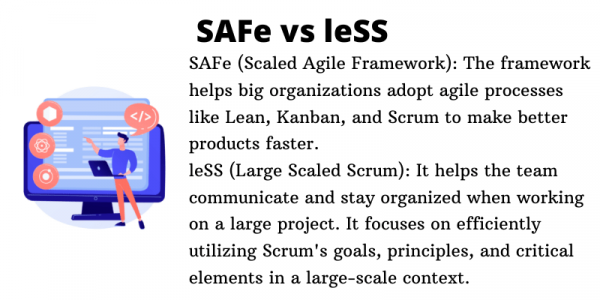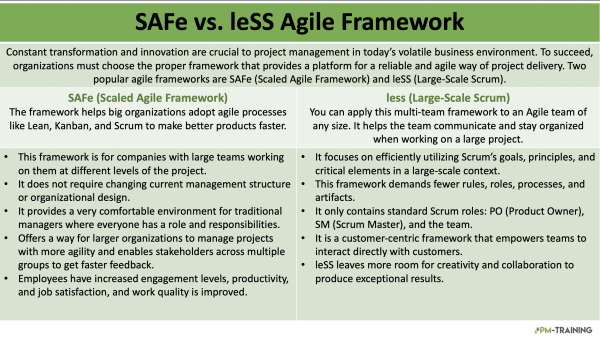SAFe (Scaled Agile Framework) and leSS (Large-Scale Scrum) are two agile scaling frameworks that provide project managers with the tools to manage and deliver successful projects. This blog post will explore SAFe vs leSS. We’ll look at their pros, cons, and limitations. By the end of this, you should have a clear understanding of which framework will work best for your organization.
What is a Scaled Agile Framework (SAFe)?
Created by Dean Leffingwell, SAFe is the most commonly used framework for implementing scaled Agile across large organizations. The framework helps big organizations adopt agile processes like Lean, Kanban, and Scrum to make better products faster.
It is for companies with large teams working on them at different levels of the project. Many organizations adopt this framework because it does not require changing their current management structure or organizational design.
It is designed to accommodate traditional organizational structures, roles, and managers. The framework provides a very comfortable environment for traditional managers where everyone has a role and responsibilities.
Moreover, it offers a way for larger organizations to manage projects with more agility and enables stakeholders across multiple groups to get faster feedback. Through the feedback loop, employees have increased engagement levels, productivity, and job satisfaction, and work quality is improved.

Pros:
- Value: It improves the agile team culture of an organization and also helps to produce higher-quality products at a faster rate. It increases the company’s ability to innovate and satisfy customers.
- Productivity: Production increase leads to improvements in system development economics and employee engagement. Productivity is critical for team members, making them feel like they are contributing more without doing something wasteful.
- Employee engagement: Organizations that use this framework have a better employee engagement rate, which helps them build a more productive, efficient, and creative workplace.
- Implementation: Everyone benefits when management and teams work together towards a shared goal. Furthermore, alignments help to establish the mission and enable the team to focus on how they will achieve their goals.
- Transparency: It ensures that everyone in the company is aware of what others are doing, which leads to improved quality products and shorter production times.
Cons:
- Heavy jargon: It use of technical terms such as runways, guardrails, program increments, and release trains can be challenging to remember. It has changed some terminologies, like a sprint to iterations, making it more challenging to understand.
- Not suitable for all business sizes: It is not appropriate for small start-ups with less than forty members. Using this framework in a start-up setting may harm your business by decreasing its ability to run parallel in volatile markets.
- Rigidness: It follows a top-down principle. It means that those in higher positions of authority within an organization are the only ones who can make decisions. Other members have no autonomy and need clarification due to a lack of clarity.
- Intensive documentation: Agile Documentation is required for every step of the process. It can be overwhelming, especially when dealing with multiple teams and stakeholders.
Limitations:
- SAFe overcame the economic difficulties of Lean development by connecting with it on a cultural level. To successfully implement this framework, you must first meet the requirements of your organization.

What is Large Scaled Scrum (leSS)?
You can apply this multi-team framework to an Agile team of any size. LeSS helps the team communicate and stay organized when working on a large project. It focuses on efficiently utilizing Scrum’s goals, principles, and critical elements in a large-scale context.
Compared to well-known Agile frameworks, this framework demands fewer rules, roles, processes, and artifacts. It only contains standard Scrum roles: PO (Product Owner), SM (Scrum Master), and the team. It is a customer-centric framework that empowers teams to interact directly with customers. Meanwhile, the PO can focus on other vital tasks, such as setting the product roadmap and establishing priorities.
By streamlining processes, leSS leaves more room for creativity and collaboration to produce exceptional results.
Pros:
- Because leSS implements the practices that the teams are already using in Scrum, utilizing the framework entails lower implementation costs.
- The Product Owner is knowledgeable in this framework and can confidently communicate with business and technical teams.
- With LeSS, you’ll need fewer people to deliver a product, so there are no exponentially more roles and overhead.
- Teams constantly communicate with customers and business stakeholders, keeping everyone up-to-date on the latest developments.
Cons:
- For a company or team that needs to be better-versed in Scrum tradition, it will be more complicated to execute LeSS because it relies on parts of Scrum.
- If your company has been utilizing a different framework, it may be difficult to switch effectively to the LeSS methodology without extensive training.
- Although having one Product Owner is beneficial, it may be too much for that one person to handle different teams simultaneously.
Limitations:
- This framework is only practical for companies that have a large Scrum structure
- As LeSS is based on Scrum, it cannot be simply integrated with other methodologies.
- With this framework, a single product owner may attempt to manage multiple teams.

SAFe vs leSS
Complexity
The SAFe framework describes a more comprehensive solution to scaling agile than LeSS, but it needs to be more adaptable to different organization sizes. Depending on the organization’s size, you implement only certain levels of SAFe’s multi-level approach.
Roles
In keeping with its principle of simplicity, LeSS only involves the roles of Product Owner, Scrum Master, and Team, which are the traditional Scrum roles. SAFe has additional roles and assigns distinct responsibilities to each part compared to LeSS.
SAFe, for example, relies heavily on the Product Owner’s role to communicate with end users and get their feedback. LeSS teams are instead encouraged to speak directly with end users, so they don’t need a separate Product Owner.
Organization structure
SAFe doesn’t prioritize organizational change to match its model and instead allows room for existing organizations who want to adopt the framework.
On the other hand, LeSS emphasizes changing organizational culture by realigning structure. It is more concerned with realigning an entire organization to fit a simplified model that supports agile workflows.
In leSS, each team is responsible for developing a product and ensuring it works correctly from start to finish. To do this, every team must have diverse skill sets. As teams grow and mature, members need to become more independent in their roles while still being able to work together cohesively with other team members. This way, tasks can be handed off smoothly between team members without disruptions.
Sprint planning
SAFE groups together multiple sprints in something called a program increment. The goal of each sprint is to finish the work that was committed. However, teams are only expected to deliver results at the end of the program increment.
Teams work together during program increment planning sessions, and SAFe uses a concept called agile release trains (ARTs), where multiple teams commit to delivering a specific set of features.
In leSS, both sprint planning and retrospectives are completed in two stages. For planning, the first stage involves each team designating two representatives to help decide which backlog items each period will include.
During the second stage, all team members can provide input or feedback. It involves an initial scrum-like meeting where we discuss progress made from the product perspective and then follow up with a report.
Deciding Which is Right for the Organization
SAFe is best for companies that make small changes over time. It provides a comprehensive framework that organizations can use to tailor their processes and align with what it prescribes.
This framework provides a comprehensive solution to scaling agile so that all parties involved feel more confident about making the transition. The language and processes will be familiar to those accustomed to traditional project management styles, making it more straightforward for upper-level managers to grasp.

On the other hand, for companies looking for a more versatile solution, leSS is the best option. It’s easy to understand from start to finish and provides a straightforward method of implementing large-scale agile development.
LeSS is a straightforward method, yet it intentionally leaves spaces for organizations to fill in themselves using their creativity to adapt the framework to match the company’s working context. It causes some ambiguity, as businesses must come to terms with utilizing it.
The SAFe framework is suitable for larger organizations because it helps them avoid radical approaches that might result in performance loss. If uncertainty and radical change are no issues for the organization, LeSS is the best option.
No two organizations are the same, and there is no one-size-fits-all solution when it comes to scaling agile. SAFe and leSS are two of the most popular frameworks organizations can use to scale agile.
SAFe provides a comprehensive framework with language and processes familiar to those accustomed to traditional project management styles. It is suitable for larger organizations that prefer to make small changes over time.
LeSS, on the other hand, provides more flexibility and leaves spaces for organizations to fill in themselves using their creativity. However, it requires a certain level of comfort with ambiguity and change for organizations that want to use it.
Ultimately, the choice between these two frameworks will depend on the organization’s size, culture, and preferences. Companies must assess their needs carefully before deciding which one to implement.
